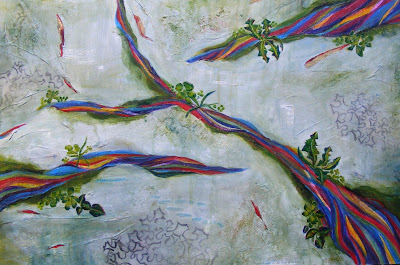 |
| To Wait |
In Pilgrim at Tinker Creek Annie Dillard writes that “The gaps are the thing” (422). As she expands,
The gaps are the clifts in the rock where you cower to see the back parts of God; they are the fissures between mountains and cells the wind lances though, the icy narrowing fjords splitting the cliffs of mystery. Go up into the gaps. If you can find them; they shift and vanish too.” (422)This painting is a reflection on the gaps, those places of stillness where with open eyes you can catch a glimpse of hope and of mystery. The beginnings of Spring are often first seen by peering into the gaps: the crack in the sidewalk where a weed grows, the bit of grass poking through last year’s dead leaves. In this painting I sought to communicate something of the hope that runs like a current below all the worn days. Hope bursts through the gaps, and beautiful things begin to grow there and foretell that more good things are to come.
But we have to wait. Waiting was a significant component of creating this piece. I tried to intentionally incorporate techniques that required extensive drying time and many layers. The background involved layers of paint, paper, and fragments of text from Theo LeSieg’s children’s story “Please Try to Remember the First of Octember.” LeSieg’s story is a tale of waiting. A basic summary of the story is that the narrator is telling a child that all of their wildest dreams will come true on the First of Octember. There is a ship, the narrator declares, that sails “to Alaska, Nebraska and Sweden, making stops in Ga-Dopps and the Garden of Eden.” And, of course, it sails on Octember the First. Sadly, the First of Octember simply isn’t coming. In the background of this piece I sought to evoke something of the angst that accompanies weathered days spent waiting for something that seem to never come. However, the seasons do change, and by looking into the gaps I see a coming Spring manifested in the beginnings of weeds and wildness.
Mingled with the groans of creation is a declaration that even a single weed growing in spite of all odds in a misshapen crack in the sidewalk is a beacon of hope that shines on the spirit and reminds us that even amidst winter’s gloom, hope beckons beyond. And as I peer through the grey mists and raindrops in search of hope, I say together with Hopkins, “Let them be left,/ O let them be left, wildness and wet;/ Long live the weeds and the wilderness yet” (Inversnaid 14-16).
